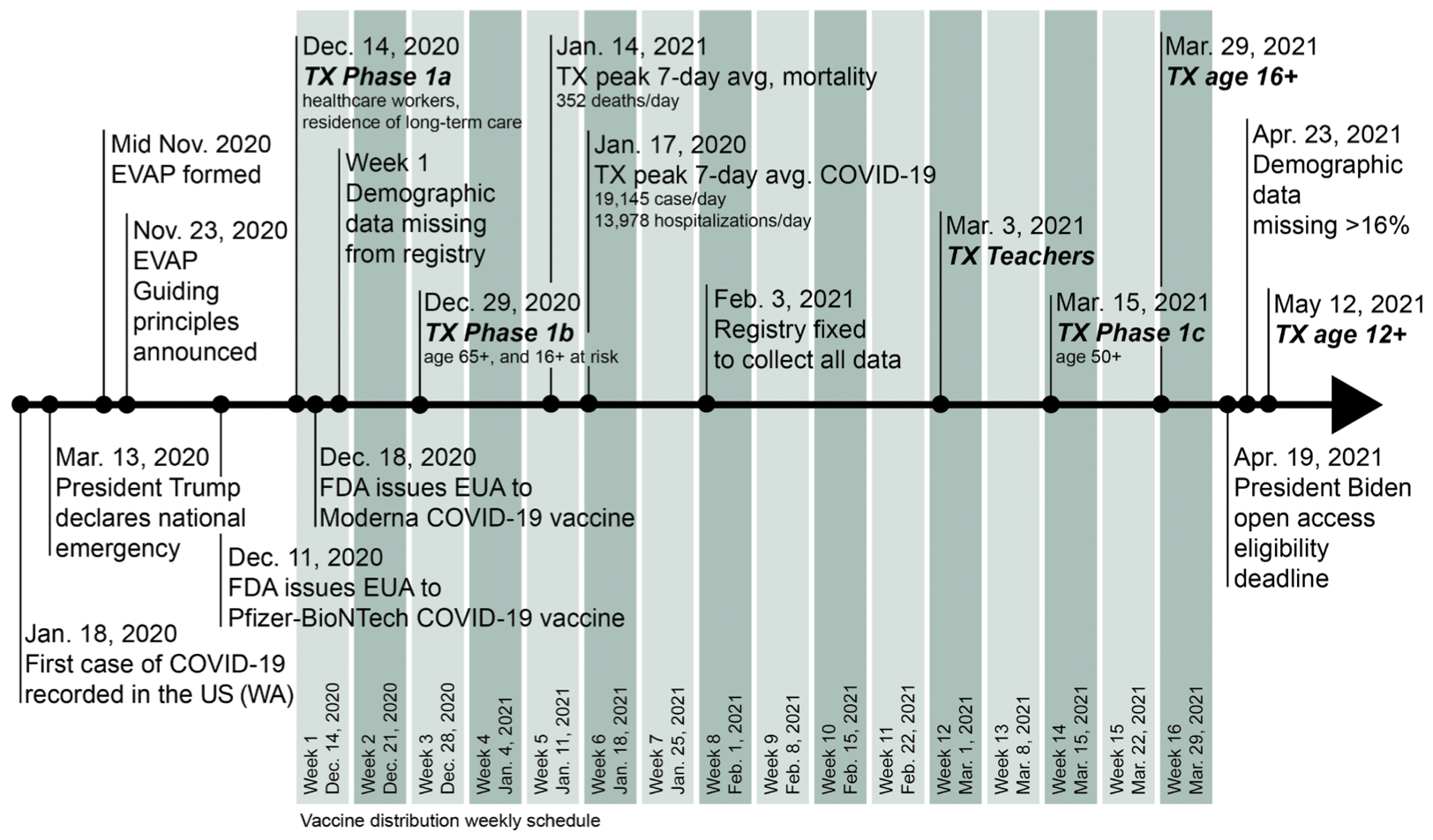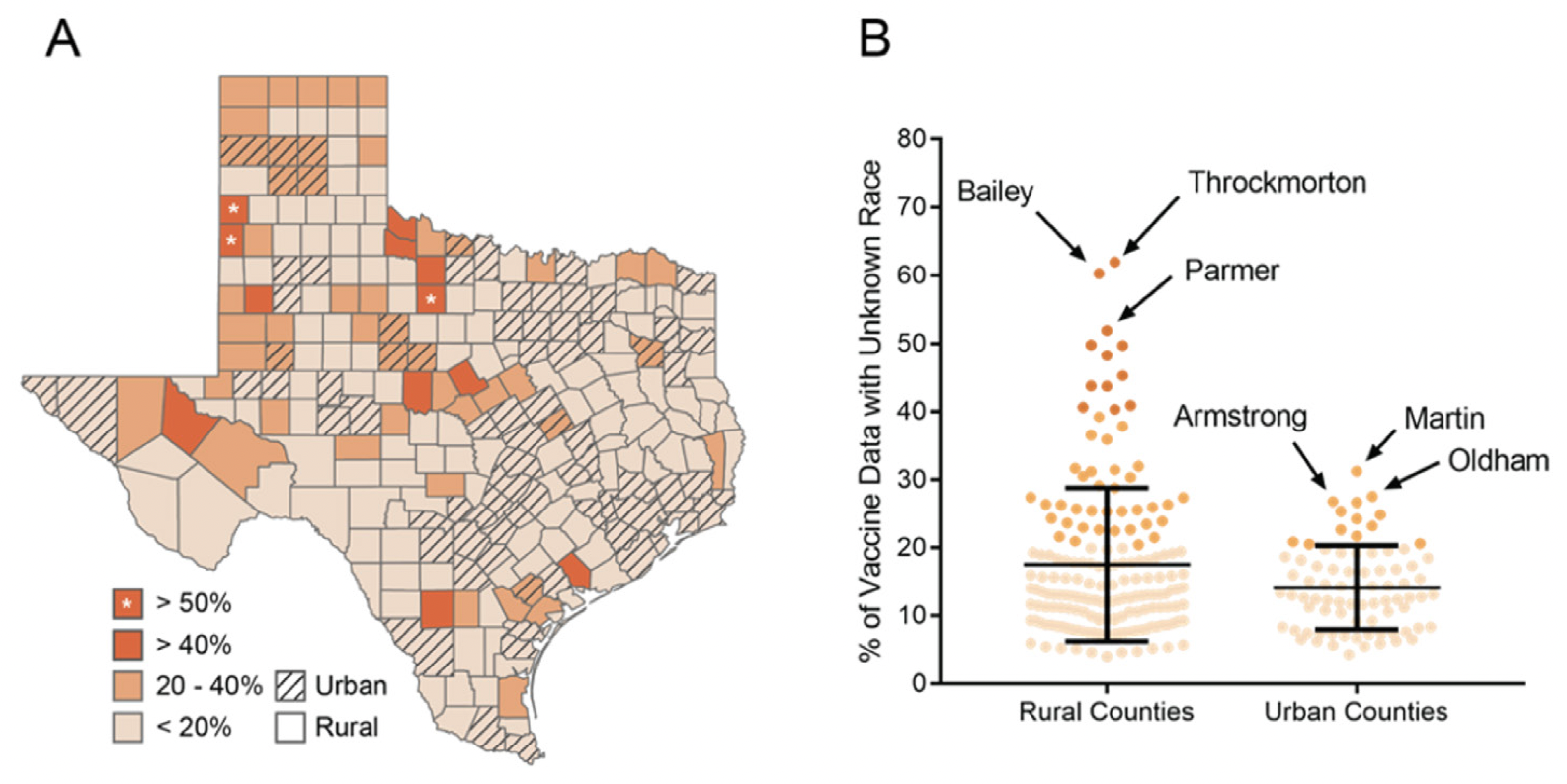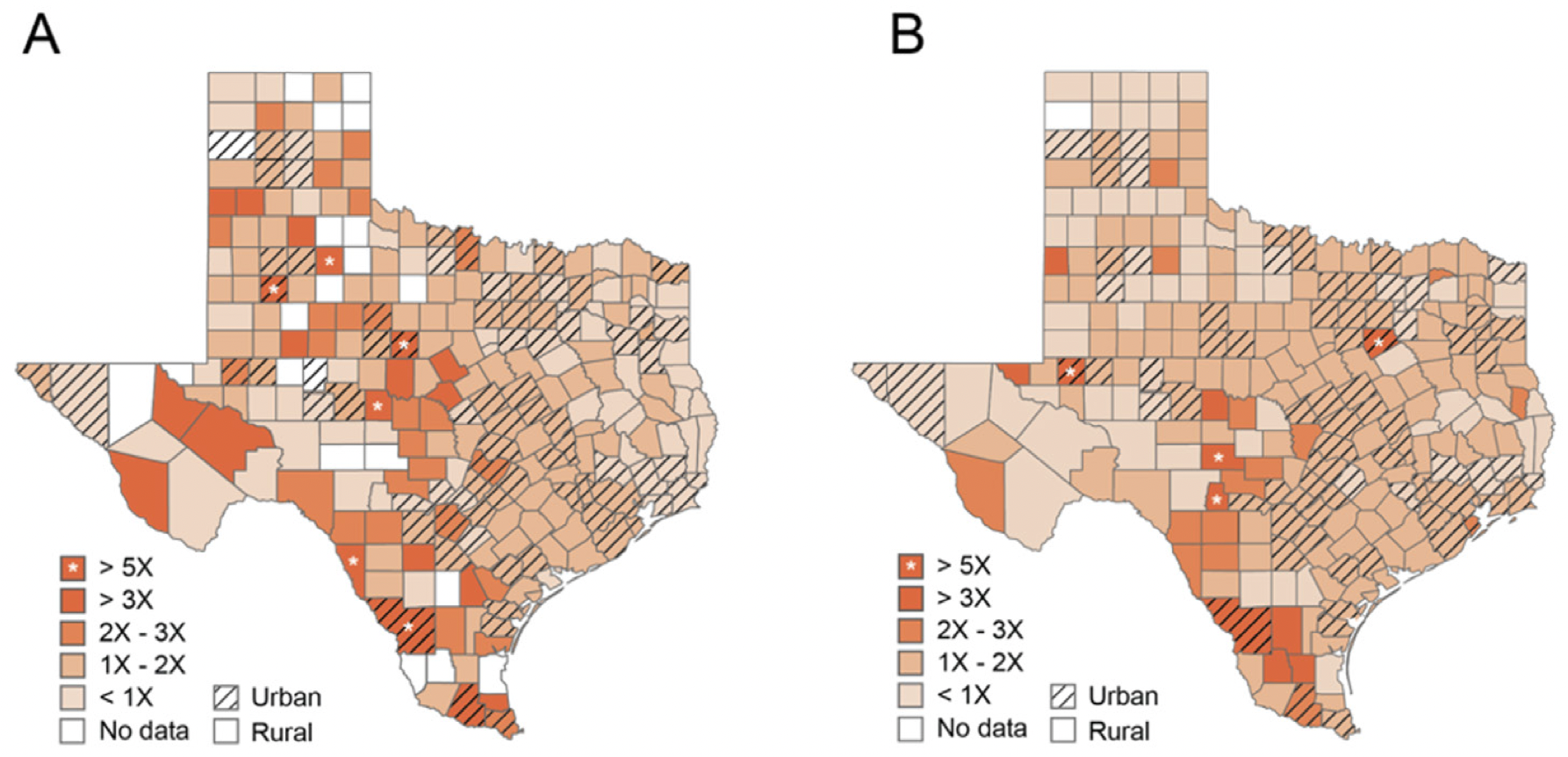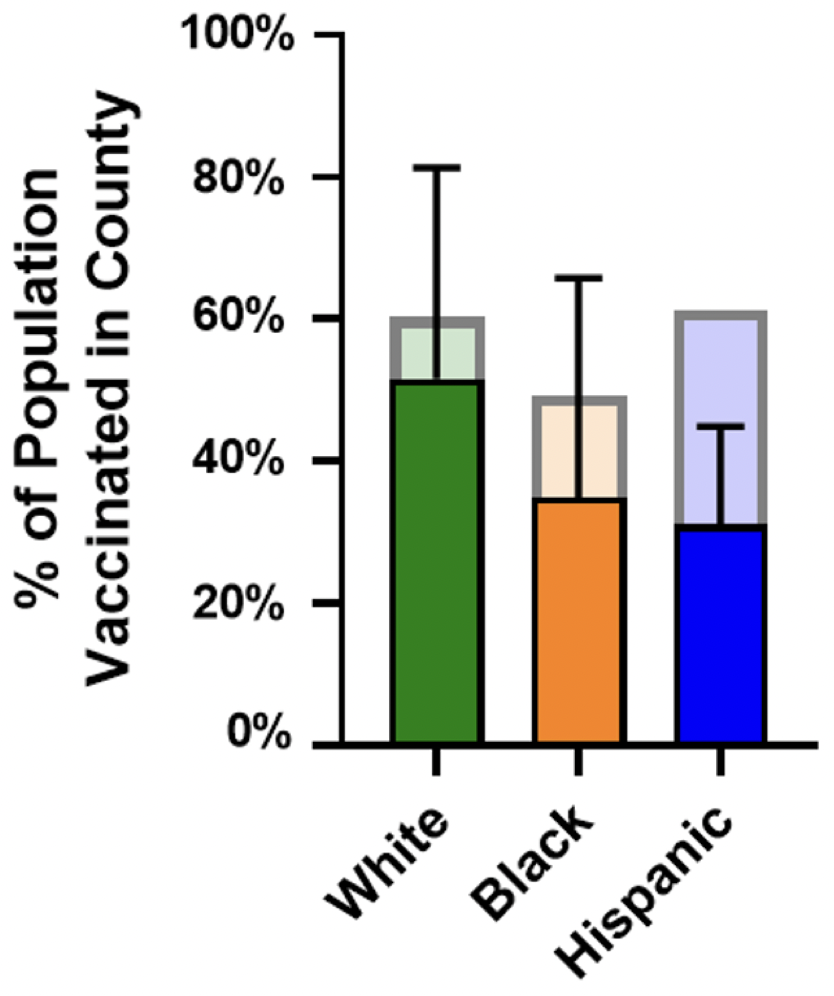Failures in COVID-19 Vaccine Administration Data Collection Complicated Efforts to Ensure Vaccine Equity in Texas

Table of Contents
Author(s)
Kirstin R.W. Matthews
Fellow in Science and Technology PolicyRekha Lakshmanan
Nonresident Scholar, Center for Health and BiosciencesShare this Publication
- Download PDF
- Print This Publication
- Cite This Publication Copy Citation
Robert A.S. Laroche, Roxanna J. Llinas, Adam M. Navara, Melody T. Tan, Rekha Lakshmanan, and Kirstin R.W. Matthews, “Failures in COVID-19 Vaccine Administration Data Collection Complicated Efforts to Ensure Vaccine Equity in Texas” (Houston: Rice University’s Baker Institute for Public Policy, March 4, 2022), https://doi.org/10.25613/7GBA-DT22.
By Robert A.S. Laroche, Roxanna J. Llinas, Adam M. Navara, Melody T. Tan, Rekha Lakshmanan and Kirstin R.W. Matthews
The equitable distribution of the COVID-19 vaccines is a critical issue due to the stark differences in health care outcomes between individuals who have received a vaccine and those who have not.1,2 Several demographic groups have historically faced barriers to accessing health care services such as vaccinations, including the elderly, rural populations, lower income groups, and communities of color.3-6 Overcoming these disadvantages and ensuring easy and affordable access are critical components of health care. Moreover, as part of an effective government response to the COVID-19 pandemic, it is necessary for members of all demographic groups to reach high rates of vaccination in order to achieve herd immunity within a region.7 In this paper, we discuss the steps taken by the Texas Department of State Health Services (TX DSHS) to ensure equitable vaccine access and to assess how shortfalls in data collection led to vaccine inequities. We recommend changes to the Texas immunization registry that will improve data collection, allow for more effective monitoring of vaccine distribution, and better prepare Texas for future public health crises.
The COVID-19 Vaccine Rollout in Texas
The TX DSHS established the Texas Expert Vaccine Allocation Panel (EVAP) in November 2020 (Figure 1) in advance of a Food and Drug Administration (FDA) Emergency Use Authorization (EUA) order for COVID-19 vaccines. The EVAP is composed of subject-matter experts from medical centers, medical schools, and public health departments throughout the state, as well as state legislators.8 They were tasked with making recommendations to the Texas Commissioner of Health, Dr. John Hellerstedt, on the distribution of COVID-19 vaccines across the state.
In preparation for the largest vaccination effort undertaken in Texas, and to quickly curb mortality and infection rates, the panel developed a series of principles that would guide policies on the equitable distribution of vaccines, with safeguarding at-risk individuals a key point of focus. The principles included provisions to: (1) protect front-line health care workers, essential workers, and vulnerable populations from infection; (2) allocate doses in a way that mitigates disparities in health care access due to demographics and geographic location; (3) use data to determine allocations; and (4) promote transparent communication with the public. These guidelines largely mirrored recommendations from the National Academies of Science, Engineering and Medicine, which drew much attention after their release in August 2020.9
The EVAP took the additional step of recommending a focus on rural communities with limited health care access and on communities with a high proportion of racial and ethnic minorities who had been disproportionately affected by COVID-19. On November 23, 2020, Gov. Greg Abbott’s office and the TX DSHS announced the guiding principles (Figure 1), which were used to identify and prioritize various population groups during different phases of vaccine distribution.10 The EVAP then worked closely with the TX DSHS Task Force on Infectious Disease Preparedness and Response to monitor COVID-19 infections and vaccinations across the state to ensure the equitable allocation of doses to the public.
Figure 1 — Timeline of U.S. COVID-19 Pandemic and Texas Vaccine Distribution

In the U.S., individual states determined which groups of people to include in each phase of vaccine eligibility. As a result, access and eligibility timelines varied from state to state. Access times across the country also varied because each state progressed through the phases at different rates. Texas’ initial COVID-19 vaccination plan granted access first to essential workers, people at high risk of severe COVID-19 illness, people at high risk of COVID-19 transmission, and people with limited access to vaccination services.11,12 However, after the development of the guiding principles, EVAP updated the first phase, 1a, to include residents of long-term health facilities because age had been identified as the highest risk factor for mortality and hospitalizations in Texas. EVAP also updated the following phase, 1b, to include individuals over 16 years old with medical conditions that put them at high-risk for severe side-effects if they contracted COVID-19.
EVAP met weekly until the end of summer 2021 (specific dates not publicly available) to track and review vaccine distribution data and to ensure all counties had an equitable allocation of vaccines and that vulnerable populations were receiving them.13,14 Indeed, by the 16th week of vaccinations in March 2021 (Figure 1), half of all Texas counties had vaccinated more than 55% of their residents over the age of 65 and nearly a fifth had vaccinated more than 70% of residents over age 65.15 To ensure an equitable distribution between rural and urban counties, EVAP allocated doses in proportion to the adult population of each county. Analysis indicated that EVAP kept dose allocations to within 0.5% of the proportional adult population for each county.16 The state’s success in adhering to EVAP guidelines for seniors and rural Texans can be attributed to the data-driven approach to resource allocation.
The Impact of Data Collection Flaws
Every state, including Texas, uses some form of database to track immunizations; this public health tool is known as an immunization registry. The registry can be used by health care providers to check patients’ immunization status, as well as by local and state health departments to address disease outbreaks and appropriately target resources and services for underserved populations. In Texas, EVAP used ImmTrac2, the state’s immunization registry, to review vaccination data while developing policies for COVID-19 vaccine distribution. EVAP later attributed its success in efficiently vaccinating elderly and rural Texans to careful observation of ImmTrac2 data. However, it noted the lack of racial and ethnic demographic data in many ImmTrac2 entries during the first week of Texas’ vaccine rollout17 (Figure 1), which hindered effective planning and action to ensure appropriate coverage of vulnerable populations.
The first weeks of vaccine distribution, in December, 2020, took place in the middle of a surge in COVID-19 infections (Figure 1). This made prioritized access for at-risk individuals critical to curbing the further spread of the virus. However, half of the reported vaccination entries during the first two months of vaccinations lacked data on race and ethnicity (Figure 1), which hindered effective monitoring and distribution to these individuals. TX DSHS did not have standardized reporting guidelines and placed the burden of developing a document and criteria for collecting patient information on individual providers, which exacerbated the problem. The registry was updated on February 3, 2021 (Figure 1) to streamline data entry and require that all submissions include data on race and ethnicity. Reports with missing data dropped from 50% of entries to only 4% by the end of the month.18
Figure 2 — Missing Racial Vaccination Data in Texas

Sources Federal Register, “Urban areas for the 2020 census-proposed criteria”; DSHS, “COVID-19 Vaccine in Texas Dashboard.”
However, by the time the correction was made, seven weeks had passed and more than 2 million vaccines had already been administered across the state. As a result, four weeks after all adults became vaccine-eligible and more than two months after the implementation of corrective data collection measures, a significant portion of the existing COVID-19 vaccine patient data still lacked inclusion of any racial data (Figure 2). Despite improvements to data collection, on average, 16.4% of total patient data collected by Texas counties did not include the race of the patient. These figures were larger in rural counties (defined by the Census Bureau as non-metropolitan counties) (Figure 2), where an average of 17.5% of their vaccine patient records did not include racial data compared to 14.1% in urban counties. In several rural counties, over 40% of vaccine records lacked key demographic information; this included over half of the vaccine records in Parmer, Bailey, and Throckmorton counties (Figure 2). The missing rural county data further hindered efforts to determine whether the state had adequately distributed vaccines to Black and Hispanic individuals in rural communities.
Figure 3 — Racial Disparities in Vaccination Rates by County

Sources Federal Register, “Urban areas for the 2020 Census-proposed criteria.” TX DSHS, COVID-19 Vaccine in Texas Dashboard.”
With the registry updated to include demographic vaccination information, we were able to identify a gap in the vaccination rate of Black and Hispanic residents compared to White residents (Figures 3 and 4). Generally, White residents were 1.65 times more likely to have received a single dose of the COVID-19 vaccine than Black residents and 1.40 times more likely than Hispanic residents, but the rates varied from county to county (Figure 3). For instance, in rural Callahan County, outside of Abilene, White residents were 22 times more likely than Black residents to have been vaccinated; in urban Ellis County, south of Dallas, White residents were over 16 times more likely than Hispanic residents to have been vaccinated. In contrast, Asian residents received the vaccine at rates similar to or greater than those of White residents. Such large discrepancies in vaccination rates may have been one factor in the overrepresentation of Black and Hispanic residents among reported deaths and hospitalizations from COVID-19 in Texas.19 While some variation in vaccination rates may be attributed to differing socio-demographic views on COVID-19 vaccines, a survey of Texas residents three months before the general rollout found minimal racial and ethnic differences among those willing to receive a COVID-19 vaccine: 59% of White residents said they would “probably,” “definitely,” or had “already” been vaccinated, compared to 48% of Black residents and 60% of Latino residents.20 Thus, a significant gap existed between an expressed interest in vaccination and the actual vaccination rate—particularly in Black and Hispanic populations, whose vaccination rates were 13 and 26 percentage points lower, respectively, than the survey suggested (Figure 4). Survey respondents were identified as either “Anglo,” “Latino,” or “African American,” and these results were compared to the vaccine data for “White,” “Hispanic,” and “Black” residents. It was not possible to compare multiracial or White-identifying Latinos with these data. These observed differences between expectation and reality indicate that additional external factors are driving vaccine inequities beyond socio-demographic or cultural considerations.
Figure 4 — Expected vs. Documented Vaccination Rates, by Race and Ethnicity

Sources “Texans and the COVID-19 Vaccine,” Hobby School of Public Affairs, University of Houston; Texas DSHS, “COVID-19 Vaccine in Texas Dashboard.”
It is difficult to confidently determine the racial and ethnic differences in vaccination rates, since 16.4% of the state’s patient data does not include information on race and ethnicity. This is a significant limitation in TX DSHS’ ability to identify inequities in vaccine access and to definitively state that individuals from all demographic and geographic groups had sufficient access to COVID-19 vaccines. It is imperative that steps be taken to ensure that thorough and accurate vaccine data collection can be conducted in the years ahead, so that Texas can be prepared to protect its residents in future public health crises.
Recommendations for Improving Texas' Public Health Response to Future Pandemics
Texas is the second-largest state in the U.S. by size and by population and as such, is home to a wide range of diverse communities. Texas’ public health institutions have the responsibility to protect the health of each community in a way that is equitable and ensures the best outcomes for all Texans. Inequitable vaccination rates among racial and ethnic groups, missing demographic data, and issues with Texas’ immunization registry during the COVID-19 pandemic have revealed areas where this responsibility is not being adequately met. We propose two specific policy recommendations that would improve Texas’ public health response to future pandemics.
Recommendation 1: Create an Opt-Out Immunization Registry System
The success of immunization registries as a tool to combat public health crises is largely dependent on the percentage of the patient population participating.21 The process for including individuals in the registry is therefore critically important to public health. Currently, Texas and Montana are the only two states with an opt-in system; the burden of enrollment is on the patient, who must choose to be part of the registry. All other states use a mandatory reporting or an opt-out system for some portion of vaccine data collection. This means that individuals are included by default but are able to permanently exempt themselves if desired.22 The participation rate in Texas’ opt-in system is significantly lower than the national average: only 3.5% of Texans over the age of 19 participate, compared to the national average of 60% in 2019.23
Changing the Texas registry to an opt-out system would open the door to people who are unaware of the registry, lack the resources to request admittance, or have no preference, while still allowing those who do not wish to participate to easily and permanently exempt themselves.
Research shows the opt-out system would be less expensive to operate: the annual cost of Texas’ opt-in system is an estimated $1.4 million per year, while an opt-out system would cost less than one-tenth that amount—$110,000 per year.24 The majority of the labor and costs of the opt-in system comes from time spent by various health care workers obtaining consent at birth and reviewing the registry for prior consent. Furthermore, switching to an opt-out system would ensure a focus on the efficient removal of non-consenting patients from the registry, rather than the more labor-intensive process of seeking explicit consent from every patient.
Beyond the heightened maintenance costs and inefficiencies of an opt-in system generally, the lack of a robust registry introduces challenges to the assessment of immunization distribution and equity even when vaccination reporting is mandated, as the case of COVID-19 demonstrates. Due to Title 25, Part 1 of the Texas Administrative Code, which requires that an immunization registry contain information regarding individuals who receive an immunization in response to a declared disaster or public health threat, the ImmTrac2 registry had to be updated from an opt-in system to one that could handle mandatory reporting.25 This update introduced problems with ensuring all demographic data were reported. The associated user interface was complicated and slow to the point that experienced health care providers had difficulty meeting the 24-hour reporting window for COVID-19 doses administered—a requirement for all enrolled vaccination providers.26 The Task Force on Infectious Diseases estimated that it would need to coordinate vaccine distribution to 14,000 health care providers in order to meet vaccine demand,27 but the modified opt-in registry was cumbersome to use and disrupted reporting of doses administered by health care providers, thereby hindering operations dependent on that feedback. If an opt-out system—one that could handle the requirements of large-scale reporting—had already been in place, this process would not have presented as many novel challenges to providers learning to navigate the system for the first time, minimizing delayed and incomplete reporting of data that directly informed the equitable distribution of COVID-19 vaccines.
Recommendation 2: Standardize Vaccine Data Collection
To address the challenges in equitable vaccine distribution in future public health crises, there is a need for routine collection of immunization data. Passed in the 87th Texas Legislature in 2021, one law, SB 1353, aimed to equip the state to identify and address inequities in vaccination rates by requiring that immunization reporting be expanded to include the age, race, and geographic location of individuals while still protecting their identity and the privacy of that personal information. Specifically, SB 1353 required TX DSHS reports on immunizations to include (1) an assessment of the disparities in vaccine access along the prior stated demographic lines, (2) an analysis of the economic benefits to reducing these disparities, and (3) recommendations for ways to reduce disparity and increase immunization rates generally. SB 1353 passed and was enacted during the 2021 state legislative session.
However, the final version was amended to only take effect if a public health disaster was declared during the preceding two years. As we described previously, many challenges to reporting immunization data during the pandemic arose due to general unfamiliarity with the collection and reporting of this information because it was not common practice during non-emergency periods. Thus, this amendment to SB 1353 reduces its impact. Therefore, to be effective, this clause should be removed and the biennial DSHS reports on immunizations should continually contain information that will promote equitable vaccination, regardless of whether there has been a recent public health crisis.
Conclusion
The failure to pass adequate policies that facilitate regular and detailed tracking of immunization data risks jeopardizing public health outcomes during the next pandemic or the current resurgence of COVID-19 variants. In the future, it is critical that Texas pursues 1) legislation strengthening the vaccine equity bill passed in 2021 (SB 1353) and 2) shifting the state’s registry from an opt-in to an opt-out system. Scientists, health professionals, and the public should advocate for these policies to ensure that the shortcomings of Texas’ health institutions during the COVID-19 pandemic are lessons learned and not mistakes repeated.
Endnotes
1. Dagan, N., N. Barda, E. Kepten, O. Miron, et al., “ BNT162b2 mRNA Covid-19 vaccine in a nationwide mass vaccination setting,” New England Journal of Medicine 384, no. 15 (2021): 1412-1423. DOI: 10.1056/ NEJMoa2101765.
2. Haas, E. J., F.J. Angulo, J.M. McLaughlin, et al.,“Impact and effectiveness of mRNA BNT162b2 vaccine against SARS-CoV-2 infections and COVID-19 cases, hospitalisations, and deaths following a nationwide vaccination campaign in Israel: an observational study using national surveillance data,” The Lancet 397, no. 10287 (2021): 1819-1829. DOI: 10.1016/S0140-6736(21)00947-8.
3. Saif-Ur-Rahman, K. M., R. Mamun, E. Eriksson, et al/, “Discrimination against the elderly in health care services: a systematic review,” Psychogeriatrics 21, no. 3 (2021): 418-429. DOI: 10.1111/psyg.12670.
4. Thomas, T. L., R. DiClemente, and S. Snell, “Overcoming the triad of rural health disparities: How local culture, lack of economic opportunity, and geographic location instigate health disparities,” Health Education Journal 73, no. 3 (2014): 285-294. DOI: 10.1177/0017896912471049.
5. Dubay, L. C. and L.A. Lebrun, “Health, behavior, and health care disparities: disentangling the effects of income and race in the United States,” International Journal of Health Services 42, no 4 (2012): 607-625. DOI: 10.2190/HS.42.4.c.
6. Abramson, C. M., M. Hashemi, and M. Sánchez-Jankowski, “Perceived discrimination in U.S. healthcare: Charting the effects of key social characteristics within and across racial groups,” Preventive Medicine Reports 2 (2015): 615-621. DOI: 10.1016/j.pmedr.2015.07.006.
7. Hildreth, J. E., and D.J. Alcendor, “Targeting COVID-19 Vaccine Hesitancy in Minority Populations in the U.S.: Implications for Herd Immunity,” Vaccines 9, no. 5 (2021): 489. DOI: 10.3390/vaccines9050489.
8. Texas Department of State Health Services. 2020, COVID-19 expert vaccine Allocation Panel, Texas Department of State Health Services, retrieved September 19, 2021.
9. National Academies of Sciences, Engineering, and Medicine, Framework for Equitable Allocation of COVID-19 Vaccine (Washington, D.C.: The National Academies Press): 2020. DOI: 10.17226/25917.
10. Office of the Texas Governor, “Governor Abbott, DSHS Announce Covid-19 Vaccine distribution plan,” press release, November 23, 2020, https://gov.texas.gov/news/post/governor-abbott-dshs-announce-covid-19-vaccine-distribution-plan.
11. Centers for Disease Control and Prevention, “Texas Interim COVID-19 Vaccination Plan,” Texas Jurisdiction Executive Summary, retrieved September 19, 2021, from https://www.cdc.gov/vaccines/covid-19/downloads/texas-jurisdiction-executive-summary.pdf.
12. Kates, J., J. Tolbert, and J. Michaud, “The COVID-19 ‘Vaccination Line’: An Update on State Prioritization Plans,” KFF, January 11, 2021, https://www.kff.org/coronavirus-covid-19/issue-brief/the-covid-19-vaccination-line-an-update-on-state-prioritization-plans/.
13. Texas Health and Human Services, “Task force on infectious disease preparedness and response,” meeting agenda, archived video(s), June 29, 2021, https://texashhsc.swagit.com/play/06292021-1073.
14. Texas Health and Human Services, “Task force on infectious disease preparedness and response,” meeting agenda, archived video(s), April 13, 2021, https://texashhsc.swagit.com/play/04142021-1198.
15. Texas Health and Human Services, “disease preparedness and response,” June 29, 2021
16. Texas Health and Human Services, “disease preparedness and response,” April 13, 2021
17. Ibid.
18. Ibid.
19. Xu, A., T. Loch-Temzelides, C. Adiole, et al., "Race and ethnic minority, local pollution, and COVID-19 deaths in Texas." Scientific Reports 12, no. 1 (2022): 1-9. DOI: 10.1038/s41598-021-04507-x.
20. “Texans and the COVID-19 Vaccine,” Hobby School of Public Affairs, University of Houston, 2021, https://uh.edu/hobby/tx2021/covid.pdf.
21. Benjamin-Chung, J. and A. Reingold, “Measuring the Success of the U.S. COVID-19 Vaccine Campaign—It’s Time to Invest in and Strengthen Immunization Information Systems,” American Journal of Public Health 111 (2021): 1078-1080. DOI:10.2105/ AJPH.2021.30617.
22. Martin, D. W., N.E. Lowery, B. Brand, et al., “Immunization Information Systems: A Decade of Progress in Law and Policy,” Journal of Public Health Management and Practice 21 (2015): 296–303. DOI: 10.1097/ PHH.0000000000000040.
23. Centers for Disease Control and Prevention, 2019 IISAR Data Participation Rates, https://www.cdc.gov/vaccines/programs/iis/annual-report-iisar/2019-data.html.
24. Boom, J. A., L.C. Sahni, C.S. Nelson, et al, “Immunization information system opt-in consent: at what cost?” Journal of Public Health Management and Practice 16 (2010): E18-25. DOI: 10.1097/PHH.0b013e3181cbc4ec.
25. Texas Register, Texas Administrative Code Title 25 Part 1, Office of the Secretary of State. Retrieved December 17, 2021, from https://texreg.sos.state.tx.us/public/readtac$ext.ViewTAC?tac_view=3&ti=25&pt=1.
26. Texas Health and Human Services, “Disease preparedness and response,” April 13, 2021
27. CDC, “Texas Interim Vaccination Plan.”
Acknowledgments
The authors would like to thank Rice University’s Baker Institute Civic Scientist Program, the Wiess School of Natural Sciences, and the Brown School of Engineering for their generous support of the 2021 Texas Science Policy Fellows Program, in which RASL, RJL and AMN were participants. In addition, the authors would like to acknowledge The Academy of Medicine, Engineering and Science of Texas and The Immunization Partnership who advised in the development and implementation of the policy fellows program. This research is also part of the Baker Institute Vaccine Project. Authors Robert A.S. Laroche, Roxanna J. Llinas, and Adam M. Navara contributed equally to this work.
This material may be quoted or reproduced without prior permission, provided appropriate credit is given to the author and Rice University’s Baker Institute for Public Policy. The views expressed herein are those of the individual author(s), and do not necessarily represent the views of Rice University’s Baker Institute for Public Policy.

